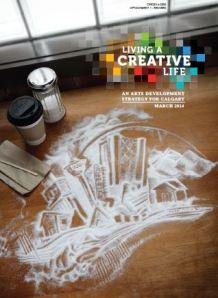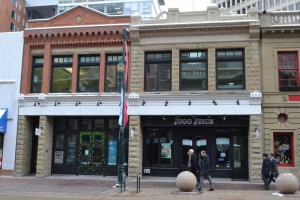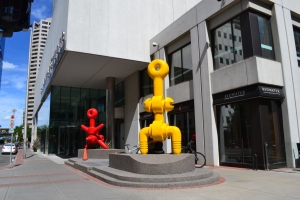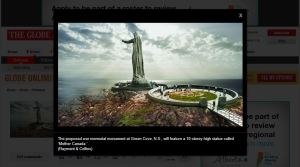
I heard about a proposal to install a very large Statue of Liberty near Fort McMurray a few days ago. My initial response?
WTF?
So I had to check it out. Sure enough, WTF Alberta? is the website and below is a screen shot from its front page.

I did a bit of investigation and the author of the story, David Climenhaga was quite upfront about this being a fabrication. Having said that, the story did pique my interest and I was fascinated at how the statue could almost double in size from the beginning of the story to the end.
* * *
It also had further interest to me as I had read about another large proposed and controversial sculpture which was mentioned in the Globe and Mail a few times during the past couple weeks and has been the subject of a few letters to the editor since that time.
Briefly, the Globe and Mail story is about a Toronto businessman, Tony Trigiani, who in cooperation with the Canadian federal political party which is currently in power are together proposing to unveil a large, patriotic “Mother Canada” sculpture on Canada Day 2017. This piece will be above the water at Green Cove, alongside the scenic Cabot Trail on Cape Breton Island, in a protected Parks Canada site which has been described as follows:
Cape Breton Highlands National Park is known for its spectacular highlands and ocean scenery. Steep cliffs and deep river canyons carve into a forested plateau bordering the Atlantic Ocean. One third of the Cabot Trail, a world-famous scenic highway, runs through the national park along the coasts and over the highlands.
The cool, maritime climate and rugged landscape permit a unique blend of Acadian, Boreal and Taiga habitats, including old-growth forests of international importance.
This is under the pretext of increasing tourism to this area of “international importance” while honoring veterans who died in past wars. As a recent Globe and Mail article stated:
The statue is just the start: Mr. Trigiani is planning to place a “We See Thee Rise Observation Deck” in front of the Mother Canada statue, and behind it “The Commemorative Ring of True Patriot Love,” a low wall featuring metal plaques naming the international cemeteries where Canadian soldiers are buried. He’s also planning a “With Glowing Hearts National Sanctuary,” as well as a restaurant, souvenir shop and interpretive centre.
Seriously?
Who thinks up these names?
This whole concept of creating a war memorial is a very difficult task. One has to find a delicate balance. The sculptor/designer/architect has to be respectful – respectful of those who have passed, and also those that remain. It is most relevant when created shortly after a conflict has ended. This is a much more difficult thing to do than many will realize.
This is something that should have a well-selected jury and public consultation involved in the selection and impacts for the entire process – from beginning to end. A war memorial is something that should not be entered into on a whim or only have one person involved in the selection. Politics must come into play, however the final decision should not be a political one. It is too important of a decision for mere politics alone.
There is only one chance to get it right, so it must be a thoughtful decision and those involved must expect controversy. There will never be consensus, except maybe, if it is well conceived, years after the fact. A couple good examples of this are Maya Lin’s Vietnam Veterans Memorial, in Washington, DC and Walter Seymour Allward’s Vimy Ridge Memorial located on Canadian soil in the middle of France.
Let’s talk about Vimy Ridge
As stated in the Globe and Mail story, this new sculpture is often referenced as Mother Canada.
This specific piece is an element of a much larger work that is currently illustrated on the back of the $20 bill.
As to be expected, more than a few commentators to the Globe and Mail stories have drawn the parallel with Russia and the term ‘Mother Russia.’ I choose not to go down that path, even though it is a legitimate path and appropriate place to travel as seen by the picture of Mother Russia in Volgograd, Russia as illustrated below.

Rather, I choose to talk about one of the sculptures at Vimy Ridge which has been often referenced in the stories themselves – a work entitled Canada Bereft that is alternatively called Mother Canada. The Encyclopedia of French Cultural Heritage in North America (from which this image below was copied) states the following about the Vimy Ridge statue:
One figure that stands apart from the ensemble is that of a woman. Facing the Douai Plain to the east, Mother Canada (also known as Canada Bereft) turns her gaze downward, her sad face symbolizing a young Canadian nation mourning its fallen sons.
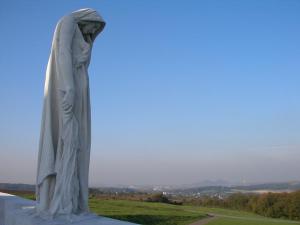
Now a bit of history
Back in 2010, retired Lt.-Gen. Roméo Dallaire (by this time he was appointed a senator) made a proposal at the 150 Canada conference hosted by the Institute for the Public Administration of Canada in Ottawa. In a front page story in the Ottawa Citizen, he indicated that he would like to see an “Ottawa version of the white stone statue” (Canada Bereft / Mother Canada illustrated above). The article went on to state that it should be “made two to three times the size of the one at Vimy, and he’d like it to be positioned in Jacques Cartier Park, just across the bridge in Gatineau.” He proposed that this be installed and ready to be unveiled in time for Canada Day 2017.
A later editorial in the Ottawa Citizen stated that, “Dallaire’s suggestion is one of the first concrete ideas to be considered for the (Canadian 150th Anniversary) celebration” in 2017.
This Ottawa proposal seemingly did not survive and died a rather hasty and quiet death – at least for the piece that was to be located in Ottawa. There has been very little conversation on this proposal after a well-conceived letter to the editor was published four years ago today as written by Jean Morin in the Ottawa Citizen. The author states:
A good look at the style of the creator of the Vimy Memorial in France may give us a few clues as to why it should NOT be imitated elsewhere. (additional emphasis given)
However on the very last day of 2013 it finally made the news, and it seems to morphed into a new life with the newly minted Never Forgotten Memorial Foundation as evidenced by this news release issued by Parks Canada last summer, which states:
This Memorial is a wonderful initiative that will give Canadians a steadfast symbol here in our country, to honour the unsurpassed bravery in the name of freedom and liberty, that Canadians soldiers displayed,” said the Honourable Peter MacKay, Minister of Justice and Attorney General of Canada and regional Minister for Nova Scotia. “The experience at the Vimy monument in France is incredibly moving, but not everyone is able to visit. This monument makes that symbol of sacrifice more accessible to Canadians.
In other words
So if I get this correctly, the people behind this Cape Breton Island project want to reproduce Allward`s Mother Canada and place her on an escarpment where land meets the sea. However, it has been changed materially. Here she is still wearing her robes from Vimy Ridge, but now she will have her arms raised while looking out to sea along with her back facing the primary viewer. In other words very much like a crucifix (except viewed from the reverse). When I hear this, my mind automatically races to the identically scaled (30 metres tall) Paul Landowski’s Christ the Redeemer, 1931 placed atop Corcovado at Rio de Janeiro, Brazil.
![Christ-the-Redeemer-High-Resolution-View-of-Brazil-Iconic-Statue-on-Corcovado-Mountain-in-Rio-de-Janeiro[1] (1024x768)](https://homeofthemuses.files.wordpress.com/2014/03/christ-the-redeemer-high-resolution-view-of-brazil-iconic-statue-on-corcovado-mountain-in-rio-de-janeiro1-1024x768.jpg?w=300&h=225)
Surprisingly, few have mentioned this, but it is absolutely necessary that we also must look at the various religious representations to the Virgin Mary. No standing female sculpture, with outstretched arms, that is also wearing a robe, cannot escape the fact that they will automatically be associated with the various representations of the Virgin Mary – especially from those who subscribe to the Catholic faith.
Probably the closest parallel to the Green Cove, Nova Scotia proposal for Mother Canada as envisioned and represented to date, based on the poses shown and stylistically, would be the 22 metre high statue of the Blessed Virgin Mary situated above the Sanctuary of the Immaculate Conception located on the summit of Cerro San Cristóbal in Santiago, Chile. This statue can be seen in the photo below.
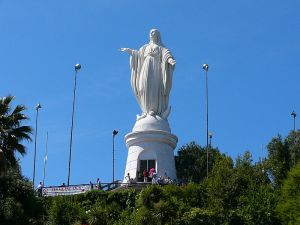
Alternatively we could have used the more modern and larger (27 metre high) representation known as Our Lady of the Rockies for comparison purposes, which is located on a mountaintop along the Continental Divide overlooking Butte, Montana. I have not illustrated it, but suffice to say, it is similar in concept to the Santiago Virgin Mary.
* * *
One thing that I have noticed in two decades of dealing in art, is that derivative works are rarely as successful as the original. This is particularly true when dealing with works that are 80 years old and accepted into the historical narrative and literature. The world is a different place now, than it was then.
From the images available, everything I have read or seen of this new piece, shows evidence of it being a highly derivative work.
It is one thing to appropriate work and create something new – it is completely different matter if it is a rehashed copy made by an anonymous artist. Quite frankly – most unoriginal pieces are by no stretch of the imagination anything close to being a national treasure. Something that will be this scale – better look like a national treasure before it even leaves the drawing board.
As Jean Morin stated back in 2010 with regards to Allward`s Mother Canada which the Cape Breton reproduction is based heavily upon and why it should not be used in a different context:
Perched on the ledge of the monument, one would expect her (Canada Bereft) to jump to her death with the next step. Fortunately the monument behind her is high enough to diminish the psychological impact of her solitary sullenness. As a pieta, she conveys utter numbness rather than sadness.
The Morin letter to the editor then goes on to state it best:
Do we want this image to be representative of us?
A culture of victimization should not be strengthened by an icon that will irradiate submission from great heights. Have we not seen enough of the mind-numbing, bleeding, genuflection-inducing crucifixes?
Tony Trigiani – your project probably is well-intentioned and honourable. I have no reason to doubt this. But I feel like Dorothy in the Wizard of Oz when I say this – we are not in Kansas anymore.
Consider trying something new instead. Something that reflects our current reality, not an idealized past.
Even though you have prepared “450 copies of a presentation book filled with images and statistics about the soldiers (that) have been sent to politicians, government offices across the country and various other entities” your project needs a lot more work. And I am not even talking about the $30-60 million of fund-raising.
* * *
Selected Notes:
Campbell, Jennifer, “Bring a bit of Vimy to Ottawa, Dallaire says; Former general wants statue of Mother Canada replicated, placed in Jacques Cartier Park”, Ottawa Citizen, March13, 2010, A1.
Editorial. “A good start for 2017”, Ottawa Citizen, March 18, 2010, A12
Morin, Jean. “I question if we want Mother Canada as our icon”, Ottawa Citizen, March 24, 2010, A13
